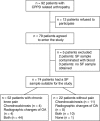Intracellular and extracellular CPPD crystals are a regular feature in synovial fluid from uninflamed joints of patients with CPPD related arthropathy
- PMID: 15941838
- PMCID: PMC1755314
- DOI: 10.1136/ard.2005.035386
Intracellular and extracellular CPPD crystals are a regular feature in synovial fluid from uninflamed joints of patients with CPPD related arthropathy
Abstract
Objectives: To determine whether calcium pyrophosphate dihydrate (CPPD) crystals can be found in the synovial fluid of non-inflamed joints in patients with CPPD related arthropathy; if so, to determine whether they interact with cells and produce subclinical inflammation in this setting.
Methods: 74 synovial fluid samples were obtained from non-inflamed knees of 74 patients with CPPD related arthropathy. Identification of CPPD crystals and synovial fluid cell counts were done manually in undiluted samples using a haematocytometric chamber. A supravital stain (Testsimplets, Boehringer Mannheim) was used to carry out differential counts and to assess the presence of intracellular crystals.
Results: All 74 samples contained CPPD crystals. The mean cell count was 301.4 cells/microl (95% confidence interval (CI), 216.6 to 386.4; range 22 to 2302.5). Mononuclear cells accounted for 83.2% (95% CI, 80.4% to 86.1%; range 43% to 99%), the rest being polymorphonuclear (PMN) cells (16.8% (95% CI, 13.9% to 19.6%; range 1% to 57%)). All the samples contained intracellular CPPD crystals, which were found in 24.0% of all the cells (95% CI, 20.1% to 27.9%; range 1% to 78%). Most of the intracellular crystals were inside mononuclear cells (22.2% of all the cells (95% CI, CI 18.5% to 25.9%)), although some PMN also contained them (1.8% of all the cells (95% CI, 1.1% to 2.4%)).
Conclusions: CPPD crystals are normally found in synovial fluid of non-inflamed joints of patients with CPPD related arthropathy, and they interact with cells. The raised cell counts and percentage of PMN suggest mild subclinical inflammation in these joints.
Figures
Similar articles
-
Detection of calcium pyrophosphate dihydrate crystals in knee meniscus by dual-energy computed tomography.J Orthop Surg Res. 2018 Apr 5;13(1):73. doi: 10.1186/s13018-018-0787-0. J Orthop Surg Res. 2018. PMID: 29622016 Free PMC article.
-
Evidence for a causal relationship between the structure, size, and load of calcium pyrophosphate dihydrate crystals, and attacks of pseudogout.Ann Rheum Dis. 1995 Oct;54(10):825-30. doi: 10.1136/ard.54.10.825. Ann Rheum Dis. 1995. PMID: 7492222 Free PMC article.
-
Synovial fluid calcium pyrophosphate dihydrate crystals and alizarin red positivity: analysis of 3000 samples.Br J Rheumatol. 1990 Apr;29(2):101-4. doi: 10.1093/rheumatology/29.2.101. Br J Rheumatol. 1990. PMID: 2157516
-
[Chondrocalcinosis due to calcium pyrophosphate deposition (CPPD). From incidental radiographic findings to CPPD crystal arthritis].Z Rheumatol. 2014 May;73(4):349-57; quiz 358-9. doi: 10.1007/s00393-014-1364-5. Z Rheumatol. 2014. PMID: 24811359 Review. German.
-
Calcium pyrophosphate deposition disease: clinical manifestations.Reumatismo. 2012 Jan 19;63(4):246-52. doi: 10.4081/reumatismo.2011.246. Reumatismo. 2012. PMID: 22303531 Review.
Cited by
-
Bilateral hamstring origin calcification: rare presentation of Gitelman syndrome.BMJ Case Rep. 2020 Jan 7;13(1):e227992. doi: 10.1136/bcr-2018-227992. BMJ Case Rep. 2020. PMID: 31915182 Free PMC article.
-
Calcium pyrophosphate crystal deposition disease: diagnosis and treatment.Open Access Rheumatol. 2014 May 8;6:39-47. doi: 10.2147/OARRR.S39039. eCollection 2014. Open Access Rheumatol. 2014. PMID: 27790033 Free PMC article. Review.
-
The detection of calcium pyrophosphate crystals in sequential synovial fluid examinations of patients with osteoarthritis: once positive, always positive.Clin Rheumatol. 2013 May;32(5):671-2. doi: 10.1007/s10067-012-2147-5. Epub 2012 Dec 28. Clin Rheumatol. 2013. PMID: 23271610
-
Pathophysiology of articular chondrocalcinosis--role of ANKH.Nat Rev Rheumatol. 2011 Feb;7(2):96-104. doi: 10.1038/nrrheum.2010.182. Epub 2010 Nov 23. Nat Rev Rheumatol. 2011. PMID: 21102543 Review.
-
Synovial Fluid from Patients with Osteoarthritis Shows Different Inflammatory Features Depending on the Presence of Calcium Pyrophosphate Crystals.Int J Mol Sci. 2023 Dec 27;25(1):393. doi: 10.3390/ijms25010393. Int J Mol Sci. 2023. PMID: 38203564 Free PMC article.
References
MeSH terms
Substances
LinkOut - more resources
Full Text Sources





